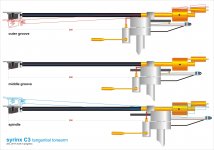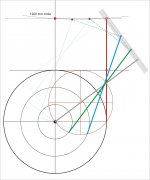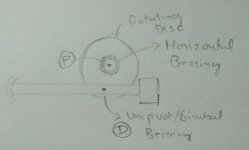to be clearer .... same answer of 2wice (just different measures)
carlo
walter: i can do just rough calcs for compliance, and more i've stiil to decide the CW weight (calc+ measures on proto) Nothing changes, so I guess the same of the lenght. Heavier problems in construction, for me badly warped or eccentric lp are for garbage.
carlo
walter: i can do just rough calcs for compliance, and more i've stiil to decide the CW weight (calc+ measures on proto) Nothing changes, so I guess the same of the lenght. Heavier problems in construction, for me badly warped or eccentric lp are for garbage.
Attachments
Last edited:
You are right, thanks for the explanation.This is incorrect, the length of mine is constant, 150mm to verticle pivot, 250mm to end of the carriage.
Even though the verticle pivot moves forward there is no way for the tracking force to change. there is only one balance, the verticle pivot.
Still waiting damned micro-bearings, I was toying with my compass, and found this strangeness. Seems a Schuch with a steamrolled flask.
Just for fun, or not?
Carlo
But imagine a Linear Pivot that travels at the opposite of his noble brothers PLT - what a converstion piece...
Just for fun, or not?
Carlo
But imagine a Linear Pivot that travels at the opposite of his noble brothers PLT - what a converstion piece...
Attachments
Impressive drawings  But please always think about vector decomposition of the stylus drag force: one vector component is in the pivot direction, the other component (if exists) is a skating force. A tangential pivot tonarm should be self-aligning, i.e. the cantilever should be tangential AND there should not be any skating force at any point of the path. (And there should be an equal opposite force to the variable and mostly unknown sylus drag).
But please always think about vector decomposition of the stylus drag force: one vector component is in the pivot direction, the other component (if exists) is a skating force. A tangential pivot tonarm should be self-aligning, i.e. the cantilever should be tangential AND there should not be any skating force at any point of the path. (And there should be an equal opposite force to the variable and mostly unknown sylus drag).
 But please always think about vector decomposition of the stylus drag force: one vector component is in the pivot direction, the other component (if exists) is a skating force. A tangential pivot tonarm should be self-aligning, i.e. the cantilever should be tangential AND there should not be any skating force at any point of the path. (And there should be an equal opposite force to the variable and mostly unknown sylus drag).
But please always think about vector decomposition of the stylus drag force: one vector component is in the pivot direction, the other component (if exists) is a skating force. A tangential pivot tonarm should be self-aligning, i.e. the cantilever should be tangential AND there should not be any skating force at any point of the path. (And there should be an equal opposite force to the variable and mostly unknown sylus drag).Build it, it will skate ...
it is one of the recurrent phrases of this thread: not yet encountered one tonearm unsuspected of doing so: if it's not the geometry, hundred other good reasons around to do so.
That graphic was made evidently for fun, studying the schuch i saw that the possible curves were infinite, so i came to this, just imposing an effectivel length = LP diameter. Amazìng, among every possible result there is also a line.
Vectors are one of the few residual memories of school days, that's why I'm in this thread instead of that of parallel trackers.
Can this arm be built? Surely not, but is up your creativity ...
Another recurring phrase.
carlo
it is one of the recurrent phrases of this thread: not yet encountered one tonearm unsuspected of doing so: if it's not the geometry, hundred other good reasons around to do so.
That graphic was made evidently for fun, studying the schuch i saw that the possible curves were infinite, so i came to this, just imposing an effectivel length = LP diameter. Amazìng, among every possible result there is also a line.
Vectors are one of the few residual memories of school days, that's why I'm in this thread instead of that of parallel trackers.
Can this arm be built? Surely not, but is up your creativity ...
Another recurring phrase.
carlo
Last edited:
Better?
Just for a weekend chat: even my compass sees a few (thousands) micrometers shifts (far less than what my digital caliper sees on my tonearms, diyed and buyed): But since a line is just a circle etc.... some mathematician maybe could find it (with oo eff. length?)
carlo again
Just for a weekend chat: even my compass sees a few (thousands) micrometers shifts (far less than what my digital caliper sees on my tonearms, diyed and buyed): But since a line is just a circle etc.... some mathematician maybe could find it (with oo eff. length?)
carlo again
Attachments
nocdplz. It would be funny to turn your new drawings upside down, with straight line going through the record (the same way true linear arm does), and circle as a tonearm guide on the top. Possibly it will work reasonably well.😀 After more than 100years we still may invent lots of new arms.😉 Noble prize ahead.
Last edited:
In post#1277, Carlo sketched an arm design based on my ideas. I want to refine the design. I want to retain the basic design and implement a guiding mechanism and I want some feedbacks.
Please ignore the armlift, I can live without it, just as I can live without it on a Dynavector arm, which is the inspiration of this design. The vertical arm, from stylus to vertical pivot distance, is about 6 inches. And horizontal arm from pivot to farthest extension (pivot to spindle), is also about 6 inches. Total length is 12 inches, 300mm. I prefer this design due to the shorter vertical arm and lower mass. Since the vertical arm is below the horizontal arm so any guiding mechanism is clearly visible at the top and probably easier to implement. The drawing is pretty close to my ideas except some details such as I prefer the roller bearings to be V-groove bearings on round rods.
I think the easiest for a guide is to use a string in a Birch geometry to guide the stylus. But a string can only pull but not push and when encountering eccentric record, will the string go slack? And when it gets to end of record will the horizontal rocking be dangerous to the stylus? Will a magnetic damping a la Dynavector style help? Will this approach have skating force? What is the best way to avoid skating force?

Please ignore the armlift, I can live without it, just as I can live without it on a Dynavector arm, which is the inspiration of this design. The vertical arm, from stylus to vertical pivot distance, is about 6 inches. And horizontal arm from pivot to farthest extension (pivot to spindle), is also about 6 inches. Total length is 12 inches, 300mm. I prefer this design due to the shorter vertical arm and lower mass. Since the vertical arm is below the horizontal arm so any guiding mechanism is clearly visible at the top and probably easier to implement. The drawing is pretty close to my ideas except some details such as I prefer the roller bearings to be V-groove bearings on round rods.
I think the easiest for a guide is to use a string in a Birch geometry to guide the stylus. But a string can only pull but not push and when encountering eccentric record, will the string go slack? And when it gets to end of record will the horizontal rocking be dangerous to the stylus? Will a magnetic damping a la Dynavector style help? Will this approach have skating force? What is the best way to avoid skating force?

Last edited:
As to avoiding skating force, the universal and simplest way is using Shure patented stylus stabilizing brush as implemented on Shure V15-4. As well, it will reduce wow and flutter caused by record warps. The only problem: I never liked the sound of V-15, with or without said brush. Possibly it is worth to try brush on other, decently sounding cartridges? Just not sure how it will affect the sound. Any experience?
Will this approach have skating force? What is the best way to avoid skating force?
Every tonearm on which the stylus travels on a curved path will skate. No exceptions.
directdriver,
I presume one end of string is attached to main tonearm wand. What is on the other end of the string ? Can you give rough sketch of its working ?
I presume one end of string is attached to main tonearm wand. What is on the other end of the string ? Can you give rough sketch of its working ?
I presume one end of string is attached to main tonearm wand. What is on the other end of the string?
One end of string is tied to the midpoint of the axle of the vertical arm and other end is tied to a fixed point outside of the arm. It's just a variation of the Birch geometry. The string is between P to D.
Every tonearm on which the stylus travels on a curved path will skate. No exceptions.
Okay.
Do you still believe the Klaudio tonearm does not have skating force?
The klaudio is simply a pivoted arm with varying offset. It, like all pivoted arms, will skate.
At the centre point of its travel the offset is zero and the skating force will also be zero. On the outer section of the record it will have a negative offset and will skate towards the spindle. On the inner section it will have positive offset and will skate outwards.
As the average offset is smaller than in most designs the average skating force will also be lower but not eradicated.
Niffy
At the centre point of its travel the offset is zero and the skating force will also be zero. On the outer section of the record it will have a negative offset and will skate towards the spindle. On the inner section it will have positive offset and will skate outwards.
As the average offset is smaller than in most designs the average skating force will also be lower but not eradicated.
Niffy
Last edited:
The klaudio is simply a pivoted arm with varying offset. It, like all pivoted arms, will skate.
That's what I thought but in post#1304 alighiszem disagrees.
Just because the stylus travels across the record in a straight line, an arm like that doesn't act like a parallel tracker.
As to avoiding skating force, the universal and simplest way is using Shure patented stylus stabilizing brush as implemented on Shure V15-4. As well, it will reduce wow and flutter caused by record warps.
The Shure damper does indeed reduce wow and flutter caused by record warps, but it does not provide any anti-skate compensation. Here is the patent:
Patent US4275888 - Stabilizing and static removing attachment for phonograph pickup cartridge - Google Patents
Note that column 2 lines 13-16 in the patent specifically state that the design of the brush does not bias the stylus i.e., the damping brush provides stabilization but does not provide any anti-skate compensation.
Ray K
This arrangement is not self-aligning, stylus drag will pull the arm off-tangent (and then it will also skate). You need to provide an opposite force to stylus drag.This should work. only two points. P and D according to Birch geometry.
Do you still believe the Klaudio tonearm does not have skating force?
I don't believe it. I know it. As I stated earlier the obvious, a force orthogonal to the possible direction of movement can not have any effect on the movement. Think at a railroad car and the wind blowing from the side. In which direction will it drive the car?
The klaudio is simply a pivoted arm with varying offset. It, like all pivoted arms, will skate.
At the centre point of its travel the offset is zero and the skating force will also be zero. On the outer section of the record it will have a negative offset and will skate towards the spindle. On the inner section it will have positive offset and will skate outwards.
As the average offset is smaller than in most designs the average skating force will also be lower but not eradicated.
Niffy
The Klaudio arm is not simply a pivoted arm, the whole contraption moves forwards and backwards synchronised with the rotation of the arm. You don't take into consideration the effect of the whole contraption pulled forward by the friction force. The turning moments affecting the arm in positive and negative direction exactly cancel each other.
- Home
- Source & Line
- Analogue Source
- Angling for 90° - tangential pivot tonearms


